#palace of soviets
Text

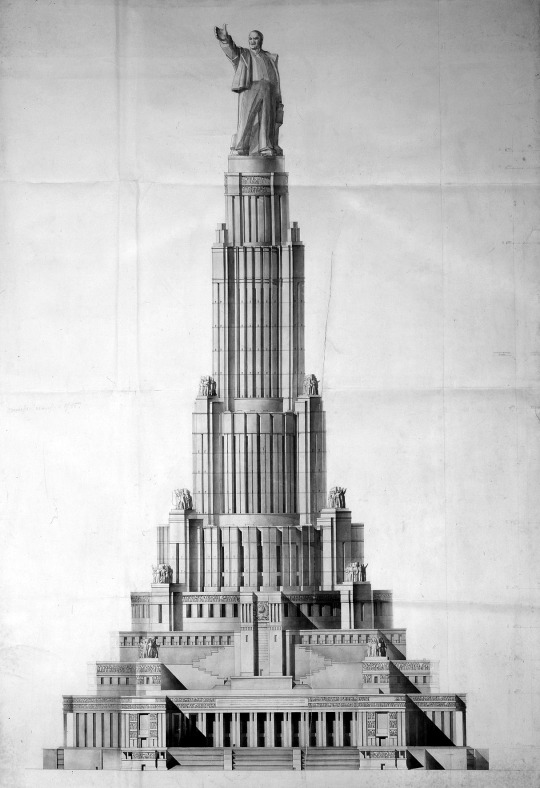
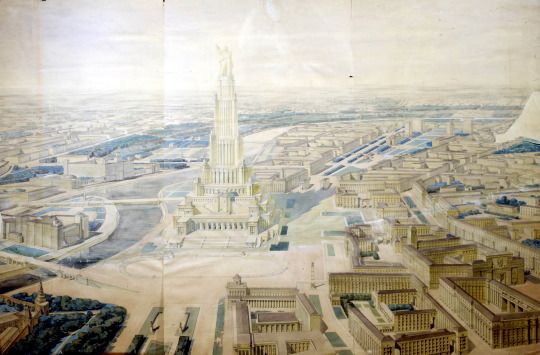



Designs for the "Palace of the Soviets," an ambitious monument to the power of the workers never to be completed. This monument to revolution was to rise above the world, carrying communism to the sky. Let it serve as a symbol of a better world that was shattered by capital, and a symbol of the world we can build.

65 notes
·
View notes
Text
youtube
I didn't want to post anything about this dude for a long time like I don't want to look like someone who writes on hype topics but lol look at this underground!
I've been there irl, it's pretty much the same as the one in my city (also a big post soviet city), the only difference was that instead of grids (like at 2:33) we have a blank wall and you can't look down at passing trains (for safety).
Russian metro is awesome, also look at stations from other cities and neighbouring countries (google pics).

"Palats Ukraina", Kyiv, Ukraine (Photo from 2010, all the Soviet decorations have now been removed)
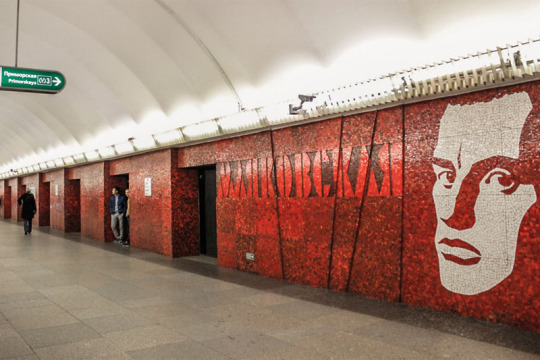
"Mayakovskaya", St. Petersburg, Russia

"Moskva", Almaty, Kazakhstan

"Botanicheskaya", Yekaterinburg, Russia

"Lefortovo", Moscow, Russia
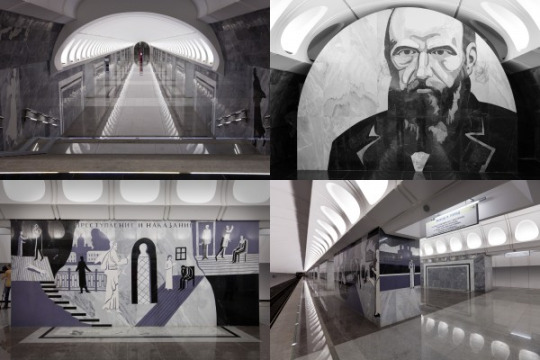
"Dostoevskaya", Moscow, Russia

"Alisher Navoiy", Tashkent, Uzbekistan
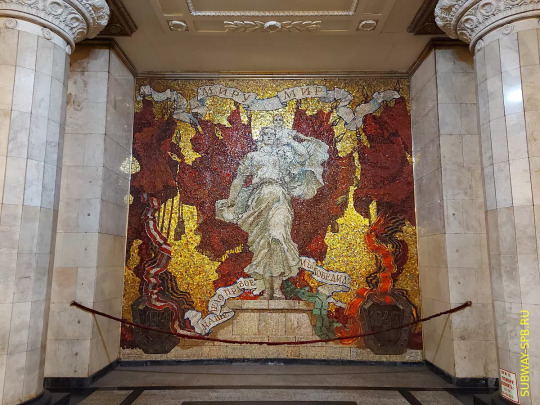

"Avtovo", St. Petersburg, Russia

"Pyatrowshchyna", Minsk, Belarus
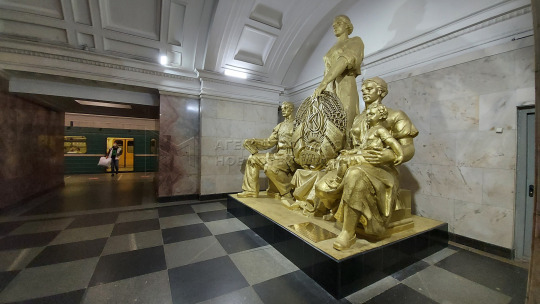

"Belorusskaya", Moscow, Russian


"Zoloti Vorota", Kyiv, Ukraine
#Youtube#Photo#Post-soviet#Subway#Russia#Ukraine#Belarus#Uzbekistan#Kazakhstan#Maybe I missed some stations that look like palaces I just chose to my taste and my taste is mostly Soviet aesthetics and national design#Some of the ones in the post I didn't even know about omg how beautiful#My favourite is Dostoyevsky station#Why isn't there a Lovecraft underground station in America?#My posts tag
2 notes
·
View notes
Text
Made in the USSR (May Day 2023)
A man sporting a “Made in the USSR” tattoo, Liteiny Prospect, Petersburg, May 1, 2023. Photo by Vadim F. Lurie, reproduced here with his kind permission
Victory Day is a memorable holiday for every citizen of St. Petersburg! During the celebration of the Great Victory, each of us remembers the heroic deeds of our grandfathers. In keeping with a long-established tradition, many musicians dedicate…

View On WordPress
#Alexander Bastrykin#Alexei Gorinov#Alexei Navalny#Arkady Kots (band)#Dmitry Pevtsov#Ella Pamfilova#Fyodor Chistyakov#Georges Moustaki#Kirill Medvedev#LDPR#Lensovet Palace of Culture#Lev Schlosberg#May Day#Mediazona#Minecraft#permanent revolution#pobedobesie (victory frenzy)#post-Soviet nostalgia#re-Sovietization#Runet#Russian Central Election Commission#Russian Constitution#Russian courts#Shavkat Mirziyoyev#Uzbekistan#Vadim Lurie#Vladimir Zhirinovsky#Yabloko
0 notes
Text
2012: Jiang Zemin When Soviet Union Collapsed
2012: Jiang Zemin When Soviet Union Collapsed
When the Soviet Union Collapsed: the Choice of Zhongnanhai
苏联解体时刻:中南海的抉择
来源:《思想理论动态参阅·文史参阅》2012年第45期 2021-03-01
作者:田毅,张恒,王晓
Keywords:
Source:《Thought and Theory Reference – Literature and History Reference》No.45, 2012
by Author: Yi Tian, Heng Zhang, Xiao Wang
In April 1990, researcher Yu Shen made a special trip to the Soviet Union to find out what “humane and democratic socialism”…
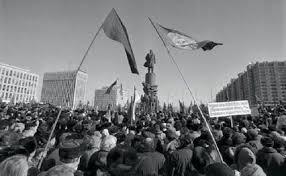
View On WordPress
#Boris Yeltsin#China#collapse#Deng#deng xiaoping#dissolution#Gorbachev#Jiang Zemin#Mikhail Gorbachev#palace coup#PRC#Qing Qichen#Soviet Union#USSR#共产党#江澤民#中国
0 notes
Text

#philately#ephemera#postage stamp#vintage stamps#vintage#stamp collecting#snail mail#soviet union#soviet union stamps#ussr stamps#ussr#fountains#palace garden#peterhof#peterhof palace#peteodvoret
1 note
·
View note
Text
incomplete list of fun stories about my dad:
at uni he and half a dozen of his friends stole a half-ton stone statue of a lion from another college, got it on a barge, and hoisted it up under London Bridge where it was found hanging the next morning
my mother and I once lost him at Trafalgar Square and he told us later he was just sitting on top of the plinth of Nelson's Column waiting for us. we never found out how a 55-year-old professor who barely ever went outside scaled a 6 metre bronze relief of the Battle of the Nile or why he thought we would look for him up there
he worked for the UN for a while and ended up in Prague on a research trip in the '60s. within three hours of landing he'd ditched his government handler and found his way to an underground anti-Soviet resistance speakeasy
he was raised Catholic. when the Vatican came out against the birth control pill he formally left the church but only after screaming "all you care about is controlling women" at his priest in public and sending the Pope a personal hate letter
when I emailed him to tell him I had started seeing a nonbinary person he wrote back with a six-paragraph rant about how much understanding of the wondrous variety of human experience had been denied to his generation
he got invited to an event at Buckingham Palace back in the '80s and responded with a letter addressed directly to the Duke of Edinburgh saying he might try and make it if he didn't have anything to do at work or anything he wanted to watch on TV that day
one time I was on a bus with him and he saw someone he thought was doing a cosplay but he was very wrong and basically went up to a stranger who was out having a perfectly normal time and complimented her on looking like a robot assassin
he started a formal debating society in his nursing home without any of the staff knowing about it
657 notes
·
View notes
Text
Oblomov’s Goncharov: The Novel That Started It All
To understand Martin Scorsese’s presentation of “Goncharov” (1973) it is first necessary to understand Oblomov’s original novel on which it is based, and indeed, the time in which it was written.

The author, Ilya Ilyich Oblomov, was a young nobleman who lived in the late 19th century in Moscow. Popular with the royal family and rich beyond all measure, he was targeted along with the royals by Lenin and the Bolsheviks when they took over Russia after the first world war (known then as World War Part I of II). To escape the fate of the royals (he is believed to have escaped the Winter Palace by only hours) he fled to Italy.
Italy was, at the time, a newly unified country of former city-states including Rome, Florence, Milan, and for some reason, Chicago, IL, the people of which may have thought “IL” stood for Italy at the time. Oblomov himself found protection in Vatican City (which was not a city, but a separate country) owing to his significant contributions to the Popesidential campaign of Pius XII. Once the revolution had died down in his former country, now part of the USSR, which is English for CCCP, which is Cyrillic for SSSR, which stood for USSR, Oblomov moved out into the “Country” (which was not a country, but just an Italian city) and began writing of his experiences.
Oblomov began his novel, Goncharov, in 1921. Its narrative was to be an epic escape from Russia to match his own, but this was not to be, as the house he moved into belonged to the family of Francesco Cuccia, known now as “Don Ciccio the All-Around Unpleasant” or “Cuccia the Pretty Damn Bloodthirsty.” Oblomov, having been tricked by certain vindictive members of the Vatican House of Commons, did not in fact have permission to live there.
As Oblomov himself tried to evade not only Don Ciccio’s mafia but Lenin’s assassins, Vatican intrigue, Templar knights trying to kill the Assassins, and of course, the order of assassins themselves, known then as “hidden ones” or simply, The Brotherhood; his novel Goncharov became a venting point for the tribulations to which he was subjected. Thus, Goncharov became the story of an epic battle between the Italian Mafia and Russians that we know today.
The novel Goncharov, published illegally in Soviet Russia as “Ivan Goncharov” or “The Many Sufferings Of Ivan Goncharov: Hope For The Best, Expect The Worst” was an underground hit. Stalin himself is said to have greatly enjoyed the novel before banning it, burning most copies of it, kidnapping its author and sending him to die in a gulag in Siberia. Though no record exists of Oblomov’s death, it does seem he was captured by Soviet secret police while visiting his parakeet in Yekaterinburg, and all record of him is lost upon his arrival in northern Siberia.
But a few copies made it out, and thanks to an English translation by Penguin Classics, the book fell into the hands of Martin Scorsese, who read the novel while in prep for his film Mean Streets, where he would go on to meet producer Domenico Procacci. Scorsese was of course too busy with his first New York epic to direct, but he agreed to co-produce the film. All that was missing was a director.
While filming the riot scene for Mean Streets though, Scorsese and his casting director happened to meet a certain extra with a peculiar name. Matteo JWHJ0715 (whose family name was changed at Ellis Island from “Jones”) had just moved to New York to achieve his dreams of Hollywood stardom, having thought Hollywood was one of New York’s suburbs. Scorsese corrected him and allayed his disappointment by inviting him to join him and Procacci for dinner.
The rest, as they say, is history.
3K notes
·
View notes
Text
Some possible sources of inspiration for Meliora design
It is known that when creating Meliora, Tobias Forge was inspired by the movie "Metropolis" and the art deco style of the 1920-30s. Here I want to share my findings of some borrowed elements in the third era.

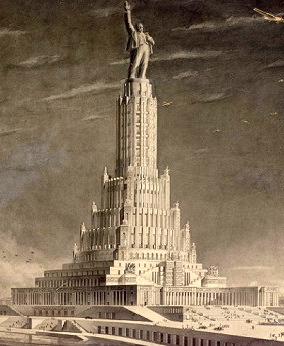
The Palace of the Soviets was a project to construct a political convention center in Moscow on the site of the demolished Cathedral of Christ the Saviour. The project was never realized. Zbigniew Bielak wrote in his blog: "Check out the rough concept sketches leading up to this apotheosis of Soviet esprit". Meliora is probably referring to the USSR as a failed utopia.



The building beneath the lustful megalomaniac resembles Boston Avenue United Methodist Church (1929).


This element is taken from the old RKO building (usually known as the General Electric Building) (1929-31). The theme of electricity is given a lot of attention in Meliora.

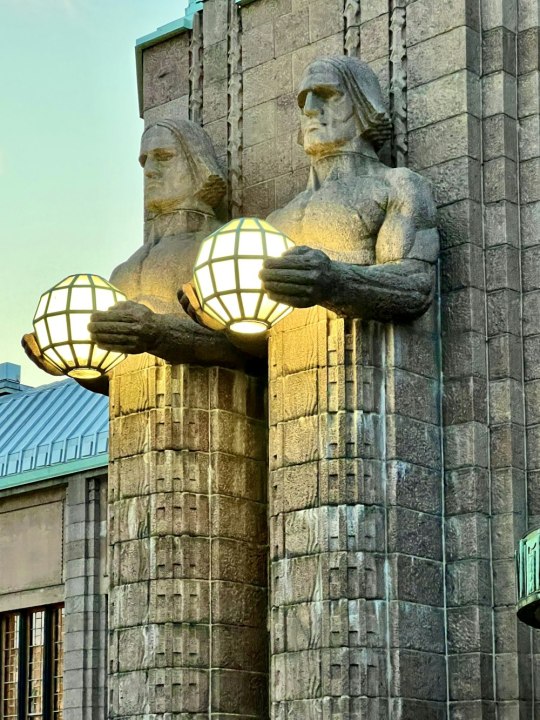
The lanterns in the hands are made in the style of the Helsinki Central Railway Station (1907) lamps. Papa Emeritus is compared to Lucifer the Light-bringer, and at the same time he is the bearer of the idea of enlightenment.

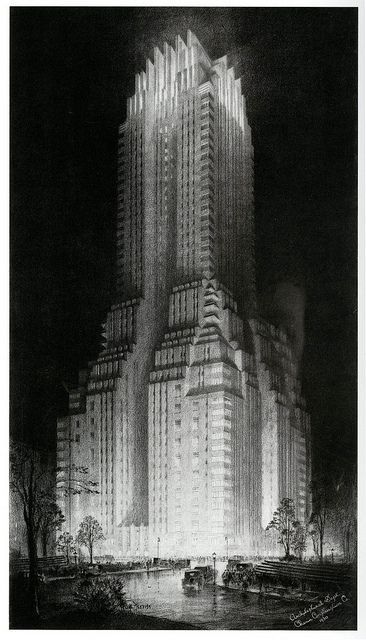
Another unrealized building, a concept by visionary artist Hugh Ferriss, can be seen in the City's urban landscape from the music video. Hugh Ferriss was an American architect and illustrator who created many images of futuristic New York in the 1920s, he's also the author of the book "The Metropolis of Tomorrow".
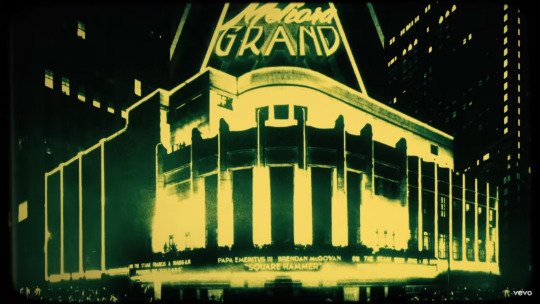


This building is the actual Odeon Cinema in Glasgow. It was built in 1934 and was originally owned by the American Paramount movie studio. A prime example of mid-1930s architectural modernism.

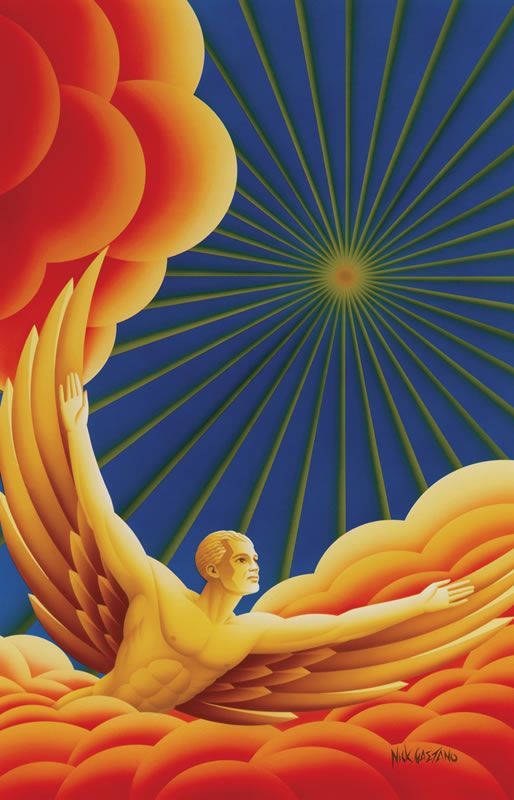
The cover of "From the Pinnacle to the Pit" is painted from Nick Gaetano's "Romantic Manifesto." It is a 2006 painting inspired by Ayn Rand's book "Atlas Shrugged".
#meliora#ghost lore#papa emeritus iii#terzo#the band ghost#ghost#papa emeritus#papa emeritus 3#papa emeritus lll#ghost fanart#ghost bc#ghost band
280 notes
·
View notes
Text

I am not going to talk about how this fucking sensual scene altered my brain chemistry forever.
However, you will have to put up with me while I'm reading Hannibal Rising because I will draw a lot of parallels.
Now for some context, while Hannibal and Mischa were Grutas's hostages, Hannibal had been chained. For so long that even after escaping Grutas, living in the soviet orphanage and moving in with his uncle, he was left with scars around his neck because of the chain and the very cold weather.
So I'm wondering if Mason tying that thing around his neck awakened anything in his memory palace.
(and I know many of you don't consider Hannibal Rising canon, however I do.)
315 notes
·
View notes
Photo


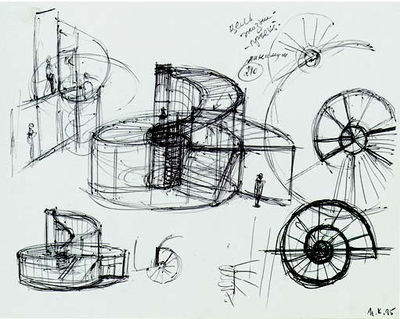

The Palace of Projects, created by husband and wife Ilya and Emilia Kabakov, is a spiraling architectural structure forty feet high and eighty feet in diameter. The nautilus-shaped Palace is constructed of a wood frame covered with stretched, white translucent fabric. It functions as an archive of utopian ideas and stories told by fictional Soviet citizens.
791 notes
·
View notes
Text

This is funny not only because it's an absolutely random collection of pics (dude, you didn't even put here Lenin's library in Moscow that genuinely looks evil because of its black marble columns or FSB headquarters and jail on Lubyanka), but also because even Stalin's era architecture usually isn't creepy (at least on photo, irl it can look very... suppressive). Not long ago there was a new film adaptation of "Master and Margarita" and to create "evil empire aesthetic" they had to straight up make a CGI Moscow using pre-WWII general plan of the city, including legendary Palace of Soviets, and also they filmed "evil soviet aesthetic" in one 1990s and one 1916 buildings.
66 notes
·
View notes
Text
Imagine that someone—perhaps a man from Florida, or maybe even a governor of Florida—criticized American support for Ukraine. Imagine that this person dismissed the war between Russia and Ukraine as a purely local matter, of no broader significance. Imagine that this person even told a far-right television personality that “while the U.S. has many vital national interests ... becoming further entangled in a territorial dispute between Ukraine and Russia is not one of them.” How would a Ukrainian respond? More to the point, how would the leader of Ukraine respond?
As it happens, an opportunity to ask that hypothetical question recently availed itself. The chair of the board of directors of The Atlantic, Laurene Powell Jobs; The Atlantic’s editor in chief, Jeffrey Goldberg; and I interviewed President Volodymyr Zelensky several days ago in the presidential palace in Kyiv. In the course of an hour-long conversation, Goldberg asked Zelensky what he would say to someone, perhaps a governor of Florida, who wonders why Americans should help Ukraine.
Zelensky, answering in English, told us that he would respond pragmatically. He didn’t want to appeal to the hearts of Americans, in other words, but to their heads. Were Americans to cut off Ukraine from ammunition and weapons, after all, there would be clear consequences in the real world, first for Ukraine’s neighbors but then for others:
If we will not have enough weapons, that means we will be weak. If we will be weak, they will occupy us. If they occupy us, they will be on the borders of Moldova and they will occupy Moldova. When they have occupied Moldova, they will [travel through] Belarus and they will occupy Latvia, Lithuania, and Estonia. That’s three Baltic countries which are members of NATO. They will occupy them. Of course, [the Balts] are brave people, and they will fight. But they are small. And they don’t have nuclear weapons. So they will be attacked by Russians because that is the policy of Russia, to take back all the countries which have been previously part of the Soviet Union.
And after that, if there were still no further response? Then, he explained, the struggle would continue:
When they will occupy NATO countries, and also be on the borders of Poland and maybe fight with Poland, the question is: Will you send all your soldiers with weapons, all your pilots, all your ships? Will you send tanks and armored vehicles with your young people? Will you do it? Because if you will not do it, you will have no NATO.
At that point, he said, Americans will face a different choice: not politicians deciding whether “to give weapons or not to give weapons” to Ukrainians, but instead, “fathers and mothers” deciding whether to send their children to fight to keep a large part of the planet, filled with America’s allies and most important trading partners, from Russian occupation.
But there would be other consequences too. One of the most horrifying weapons that Russia has used against Ukraine is the Iranian-manufactured Shahed drone, which has no purpose other than to kill civilians. After these drones are used to subdue Ukraine, Zelensky asked, how long would it be before they are used against Israel? If Russia can attack a smaller neighbor with impunity, regimes such as Iran’s are sure to take note. So then the question arises again: “When they will try to occupy Israel, will the United States help Israel? That is the question. Very pragmatic.”
Finally, Zelensky posed a third question. During the war, Ukraine has been attacked by rockets, cruise missiles, ballistic missiles—“not hundreds, but thousands”:
So what will you do when Russia will use rockets to attack your allies, to [attack] civilian people? And what will you do when Russia, after that, if they do not see [opposition] from big countries like the United States? What will you do if they will use rockets on your territory?
And this was his answer: Help us fight them here, help us defeat them here, and you won’t have to fight them anywhere else. Help us preserve some kind of open, normal society, using our soldiers and not your soldiers. That will help you preserve your open, normal society, and that of others too. Help Ukraine fight Russia now so that no one else has to fight Russia later, and so that harder and more painful choices don’t have to be made down the line.
“It’s about nature. It’s about life,” he said. “That’s it.”
#current events#warfare#politics#russian politics#american politics#russo-ukrainian war#2022 russian invasion of ukraine#russia#ukraine#usa#volodymyr zelenskyy#ron desantis#nato
245 notes
·
View notes
Text
Alexei Navalny returned to Russia in January 2021. Right before he boarded the plane, he posted a film titled “Putin’s Palace: The Story of the World’s Largest Bribe” on YouTube. The video, nearly two hours long, was an extraordinary feat of investigative reporting. Using secret plans, drone footage, 3-D visualizations, and the testimony of construction workers, Navalny’s video told the story of a hideous $1.3 billion Black Sea villa containing every luxury that a dictator could imagine: a hookah bar, a hockey rink, a helipad, a vineyard, an oyster farm, a church. The video also described the eye-watering costs and the financial trickery that had gone into the construction of the palace on behalf of its true owner, Vladimir Putin.
But the power of the film was not just in the pictures, or even in the descriptions of money spent. The power was in the style, the humor, and the Hollywood-level professionalism of the film, much of which was imparted by Navalny himself. This was his extraordinary gift: He could take the dry facts of kleptocracy—the numbers and statistics that usually bog down even the best financial journalists—and make them entertaining. On-screen, he was just an ordinary Russian, sometimes shocked by the scale of the graft, sometimes mocking the bad taste. He seemed real to other ordinary Russians, and he told stories that had relevance to their lives. You have bad roads and poor health care, he told Russians, because they have hockey rinks and hookah bars.
And Russians listened. A poll conducted in Russia a month after the video appeared revealed that one in four Russians had seen it. Another 40 percent had heard about it. It’s safe to guess that in the three years that have elapsed since then, those numbers have risen. To date, that video has been viewed 129 million times.
Navalny is now presumed dead. The Russian prison system has said he collapsed after months of ill health. Perhaps he was murdered more directly, but the details don’t matter: The Russian state killed him. Putin killed him—because of his political success, because of his ability to reach people with the truth, and because of his talent for breaking through the fog of propaganda that now blinds his countrymen, and some of ours as well.
He is also dead because he returned to Russia from exile in 2021, having already been poisoned twice, knowing he would be arrested. By doing so he turned himself from an ordinary Russian into something else: a model of what civic courage can look like, in a country that has very little of it. Not only did he tell the truth, but he wanted to do so inside Russia, where Russians could hear him. This is what I wrote at the time: “If Navalny is showing his countrymen how to be courageous, Putin wants to show them that courage is useless.”
That Putin still feared Navalny was clear in December, when the regime moved him to a distant arctic prison to stop him from communicating with his friends and his family. He had been in touch with many people; I have seen some of his prison messages, sent secretly via lawyers, policemen, and guards, just as Gulag prisoners once sent messages in Stalin’s Soviet Union. He remained the spirit behind the Anti-Corruption Foundation, a team of Russian exiles who continue to investigate Russian corruption and tell the truth to Russians, even from abroad. (I have served on the foundation’s advisory board.) Earlier this week, before his alleged collapse, he sent a Valentine’s Day message to his wife, Yulia, on Telegram: “I feel that you are there every second, and I love you more and more.”
Navalny’s decision to return to Russia and go to jail inspired respect even among people who didn’t like him, didn’t agree with him, or found fault with him. He was also a model for other dissidents in other violent autocracies around the world. Only minutes after his death was announced, I spoke with Sviatlana Tsikhanouskaya, the Belarusian opposition leader. “We are worried for our people too,” she told me. If Putin can kill Navalny with impunity, then dictators elsewhere might feel empowered to kill other brave people.
The enormous contrast between Navalny’s civic courage and the corruption of Putin’s regime will remain. Putin is fighting a bloody, lawless, unnecessary war, in which hundreds of thousands of ordinary Russians have been killed or wounded, for no reason other than to serve his own egotistical vision. He is running a cowardly, micromanaged reelection campaign, one in which all real opponents are eliminated and the only candidate who gets airtime is himself. Instead of facing real questions or challenges, he meets tame propagandists such as Tucker Carlson, to whom he offers nothing more than lengthy, circular, and completely false versions of history.
Even behind bars Navalny was a real threat to Putin, because he was living proof that courage is possible, that truth exists, that Russia could be a different kind of country. For a dictator who survives thanks to lies and violence, that kind of challenge was intolerable. Now Putin will be forced to fight against Navalny’s memory, and that is a battle he will never win.
68 notes
·
View notes
Text
hey, so— i’ve been ~officially writing a web serial since 2021 (unofficially, since at least 2014). Updates are currently very irregular, but i’m definitely still working on it!
✨🧿 THE BITTER DROP 🧿✨
modern fantasy romance about gay/trans Eastern Bloc Jews, set in a secondary world counterpart of early Soviet communes
The lounge is nearly empty tonight; all the action is downstairs at the grinding workshop — in the basement discotheque; you if I’m to have any hope of pulling, that’s where I ought to go but … ekh, I’m foggy tonight, between the psychosis and the laudanum for the pain what likes to haunt nefilim and the horse pills they made me take at the Mamka — nu okay, I skipped tonight’s dose so I can drink but like, neuroleptics don’t let go that quick — and as the brainfog settles on my thoughts, it turns to hoarfrost and my will seizes up like a rusty hinge.
Lev/Lyubov Morgenshtern, a queeny bigender flamer who’d once been one of the Pale’s youngest-ever ordained rabbonim, has just returned to the Talons Ghetto sovyet — an autonomous workers-and-peasants commune of the kind that directly preceded the Soviet Union (and indeed the thing that the USSR named itself after).
Lev is fresh off a stint on a psych ward that’d followed a far longer stint living in the tzarist-held half of Svet Dmitrin with a bougie respectability-obsessed ex-boyfriend — he’s got nowhere to sleep, no assurance her old friends, Red Guard and civilian both, would want to see them and the only workable plan she’s got is to find someone willing and soft-hearted to take him home for the night …
… and what luck if their rescuer, a medical necromancer by the name of Anzu Menelikov (Nyura to friends and lovers) is a beautiful trans flamer from a prominent rabbinical family! who better to welcome Lyubov home than a fellow hothouse flower and dedicated scholar? and does it matter if Nyura did anything the White Guard might still bear a grudge about? after all, most of the old Ghetto walls are still safely intact, and it’s not like Reb Doktor Menelikov personally set the Winter Palace on fire, right?
i’d say if you liked the Baru Cormorant series, Michael Chabon’s The Yiddish Policemen’s Union and Gentlemen of the Road, Fallen London and its associated games, China Miéville’s oeuvre, and Disco Elysium, this’d probably be your thing!
content warnings
(under the cut)
reclaimed homophobic slurs
the narrator has a history of psychiatric institutionalisation
homophobia, transphobia, transmisogyny and antisemitism are environmental hazards in the setting, though by far not the focus
#the bitter drop#web serial#web fiction#web novel#fiction#tell your friends#and tell me if you read it tbh
78 notes
·
View notes
Text

Soviet rock band "Kino" performing at the Palace of Culture during the 2nd Leningrad Rock Club festival, 1984.
#viktor tsoi#kino#russia#russian#ussr#soviet aesthetic#soviet#soviet union#russian history#sovietwave
73 notes
·
View notes
Text
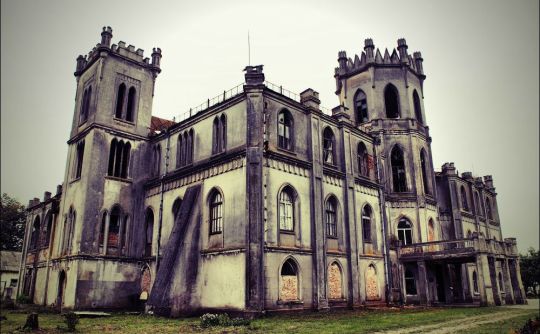



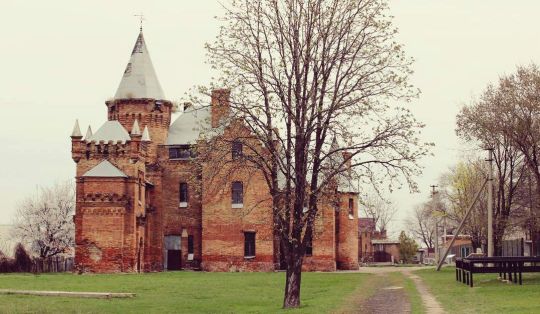
Samples of abandoned palace architecture of Ukraine:
Tereshchenko Palace
The village of Chervone, Andrushiv district, Zhytomyr region.
The style of the palace is Neo-Gothic. It was built at the beginning of the 19th century at the expense of the Polish nobleman Adolf Groholsky. The estate was bought by Ukrainian industrialists and philanthropists - Tereshchenko brothers, who expanded the palace and the park.
The palace began to fall into disrepair with the arrival of communist regime. After 1917 here were located a children's boarding school and vocational school. Later the building survived a fire.
Nowadays, the palace of the Groholsky-Tereshchenkos belongs to the women's monastery of the Holy Nativity of Christ. In addition to the palace, the stables, the left wing and the fountain have been preserved.
Oosten-Saken Palace
Kyiv region, Kyiv-Svyatoshinskyi district, between Myrotske and Nemishaeve villages.
It is believed that the palace was built in the 19th century at the expense of Count Karl Saken. It was an Ancestral estate. The count's descendants had the surname Osten-Saken, which is where the conventional name of the estate comes from.
In Soviet times, the palace housed a biochemical plant. After a fire broke out at the factory, the palace burned down and only the walls remained.
Dakhovsky Palace
Village of Leskovo, Monastyryshche district, Cherkasy region.
The style of the building is Neo-Gothic. Leskiv Palace was built at the expense of magnate Casimir Dakhovsky in the middle of the 19th century.
The complex consists of a palace, outbuildings, service premises and stables. In June 2013, the palace received the status of a historical and cultural reserve of state importance.
Palace of the Muravyov-Apostles
the outskirts of Khomutets village, Myrhorod district, Poltava region. The estate was built at the beginning of the 19th century by a descendant of Ukrainian hetman Danylo Apostol - diplomat Ivan Muravyov-Apostol. The palace is surrounded by considerable French park. Ivan Muravyov-Apostol left the estate and went abroad after the failure of the Decembrist uprising.
Popov estate
Vasylivka town, Zaporizhzhia region.
The style of the preserved buildings is Neo-Gothic. Vasyl Popov, a general of the Russian Empire, founded a settlement here at the end of the 17th century. In the 19th century, the grandson of the general, who was also named Vasyl, developed the estate and built numerous farm buildings.
Source: https://tsn.ua/tourism/10-zanedbanih-palaciv-ta-zamkiv-ukrayini-yaki-mozhut-zniknuti-nazavzhdi-1040310.html
#ukraine#eastern europe#architecture#palace#history#palace architecture#abandoned buildings#abandoned#abandoned palaces
58 notes
·
View notes